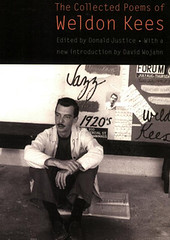Pat Ivers and Emily Armstrong continue sorting through their archives of punk-era concert footage as it’s digitized for the Downtown Collection at N.Y.U.’s Fales Library.
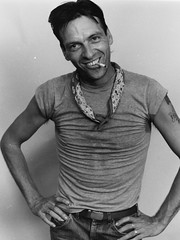 Emily Armstrong Max Blagg
Emily Armstrong Max BlaggAugust 1980 in the Lower East Side: it was the Summer of Heroin.
Clinton Street was not yet restaurant row – it was lined with shooting galleries, rows of cars with Jersey plates and steerers plying their wares. “We got Snoopy, 7-Up, Yellow Bag; we got the stuff that can kill you, man!” – a pitch both fascinating and confounding. Junkies were on every other corner and street muggings were rampant. Home break-ins were a fact of life so common that it became uninteresting unless it happened to you.
Which it did. We came home one night to find our apartment tossed and our video equipment gone. At the time, we were running the Video Lounge at Danceteria and our coworkers rallied to our support, organizing a benefit. Poet Max Blagg, then a bartender at the club, read his epic, “Smack Yourself Senseless.” His poem, a brutal five minute take-down of heroin chic, was a comfort. Read more…
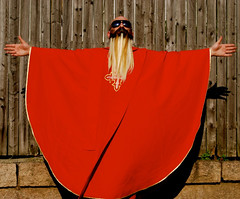 Courtesy B. Dolan B. Dolan in full regalia.
Courtesy B. Dolan B. Dolan in full regalia.This Sunday, the Church of Love and Ruin Tour returns to the East Village, bringing with it a kaleidoscopic array of acts ranging from independent rap sensation Sage Francis to a marching band to the gender-bending practitioners of sissy bounce. The tour’s headliner and mastermind, B. Dolan (Bernard Dolan), hopes to get the New York audience – “which can stereotypically be very stoic and non-responsive,” he said – wiling out with the help of a new host, a drag queen by the name of Yekaterina Petrovna Zamolodchikova. “I predict that she is about to become a hip-hop legend,” he told The Local, adding that “what she’s going to do to these audiences will be remembered by their children’s children.”
You heard it here first. Mr. Dolan recently sat down with us to discuss his East Village origins as well as the significance of bringing the tour back to where he got his start.
Q.
What inspired you to make a name for yourself in the East Village?
A.
I grew up in an old mill town outside Providence, R.I., and hip-hop culture was nowhere near me really. I discovered rap via an older cousin, and then scavenged for what I could find. I knew shortly after that I wanted to be a writer-rapper and that my favorite hip-hop came from New York City. So that’s where I headed in 1999, as soon as I finished high school. I discovered the scene in the East Village and started performing there. Read more…
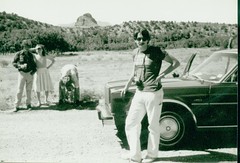 Allen Ginsberg Bob Rosenthal, front. Back, from left: Gregory
Allen Ginsberg Bob Rosenthal, front. Back, from left: Gregory
Corso, Shelley Kraut, and Peter Orlovsky holding
Aliah Rosenthal. 1980. .As National Poetry Month winds down, let’s hear more from Bob Rosenthal. Earlier, in the first and then the second installment of our interview conducted at Allen Ginsberg’s former apartment on East 12th Street, where Mr. Rosenthal worked as his secretary for nearly two decades, we heard about Ginsberg’s daily routine, his social sphere, and his love of the East Village. Now, Mr. Rosenthal recalls the poet’s romantic life, his way with strangers, and his tumultuous relationship with Peter Orlovsky – fellow poet, former lover, and longtime companion.
Allen and Peter
Harry Smith would be living here and walking through and making films, and Peter Orlovsky’s brother Julius would be here. I would listen to music and then Julius would say, “Bob, would you like me to turn the music off?” and I’d say, “No, Julius, I’m enjoying this music,” and then 30 seconds later he’d say, “Bob, would you like me to turn this music off?” And after a couple of times I’d say, “Okay, Julius, I have an idea: why don’t you turn the music off?” Denise [Mercedes] and her bandmates would try to get Julius to swear and they’d try to trick him but he was so smart and they could never trick him into saying a swear word. It was really kind of zany. Read more…
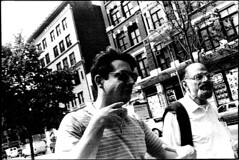 Rosenthal and Ginsberg.
Rosenthal and Ginsberg.Earlier this week, Allen Ginsberg’s secretary of 20 years, Bob Rosenthal, shared memories of his former employer – some of which will be included in a memoir he recently completed, “Straight Around Allen.” Speaking to The Local at Ginsberg’s former apartment on East 12th Street, where the two worked alongside each other for so long, he recalled the great poet’s daily routine, his tastes in literature and music, his mail and telephone communications, and his ways with money. Today, in our second installment, Mr. Rosenthal talks about Ginsberg’s social sphere during his two decades in the so-called poets building. Check back tomorrow for still more from this candid interview.
Allen’s East Village
People would always call Allen and say, “Allen, come to my shangri-la in Hawaii,” and here or there. He would never go. A vacation for Allen was coming back and having nothing to do in the East Village. He would often go to the poetry readings at St. Mark’s. He loved the mushroom barley soup at the Kiev. And The New York Times – he just loved it. He hung around Tompkins Square, wrote a lot of one-line poems about skinheads there. And he was a natural. I think because he always felt free here. Read more…
A cultural oddity of the East Village is that it has more often been a home to poets than novelists. Some of the poets (Allen Ginsberg, W.H. Auden) are about as famous as poets get. Others (Edwin Denby, Bernadette Mayer) are known to only a few. The vast majority, as you would expect, are almost completely unknown.
Weldon Kees, who lived at 129 E. 10th Street (the apartment building directly next to St. Mark’s Church) from October 1943 until November 1945, and later rented a loft at 179 Stanton Street in the Lower East Side, is an exception. As a cult figure with an ardent following, he’s certainly known to some people – but his connection to the East Village has been all but forgotten. Perhaps that’s appropriate: An absence as much as a presence, a shadow where a human should be, Kees is the Harry Lime of modern American poetry, as in the character played by Orson Welles in “The Third Man”: Now you see him, now you don’t. Read more…
 Phillip Kalantzis-Cope
Phillip Kalantzis-Cope Good morning, East Village.
City Room profiles Larry Fagin, a poet and teacher who, at the age of 74, is “one of the East Village’s last standing bohemians.” He lives in a two-bedroom walk-up in Allen Ginsberg’s old building. His rent has almost tripled since he took the apartment in 1968 – yet he’s still paying only $150 a month.
EV Grieve notes that the Upright Citizens Brigade has opened its outpost on East 3rd Street, complete with Hot Chicks Room.
Thought Delancey was a bad street to bike on? Brooklyn Spoke thinks the Bowery is also a “death-trap” for bikers, and believes there has been “too much focus on what’s happening on the Manhattan Bridge and not enough on what’s happening when cyclists get off of it.” Read more…







